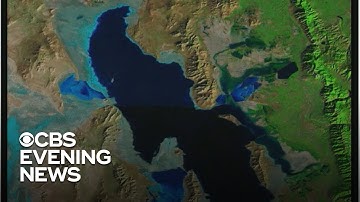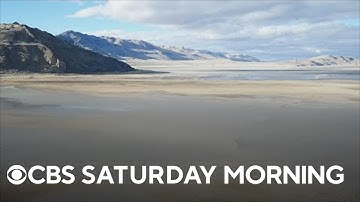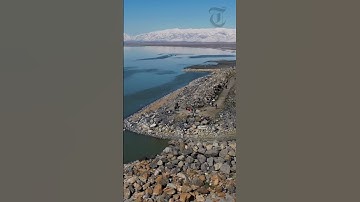Long-term water shortage management in Salt Lake City: The state capital and largest city in Utah.
Long-term water shortage management – Everything you need to know!
Finding Solutions for the Great Lake of Salt
Water Conservation: Dousing Ourselves to Save Our Puddle
Let’s embrace the “Less is More” mantra, my fellow Utahns! Shorter showers? They’re not just a blessing for our water bills, they’re a lifeline for our beloved lake! We’ll hold our water as if it were liquid gold, and those leaky faucets? They’ll be our arch-nemeses in this battle against dehydration.
The Great Salt Puddle Puzzle:
If you imagine the Great Salt Lake as a giant, salty puddle in the middle of Utah, you’re not far off. And just like any good puddle, when the sun gets a little too friendly, it starts evaporating like a runaway train. And that’s where climate change comes into play—it’s making our puddle nice and toasty, speeding up the dehydration process.
The Impact of a Shrinking Puddle: It’s Not Just a Matter of Puddles
Our Great Salt Puddle isn’t just there to make Utah a little bit salty. It’s a haven for thousands of our feathered friends, from migratory birds to the local mallards that have lost their way to the Cheesecake Factory. They rely on this puddle for their daily dose of briney snacks and a place to crash after a long migrating flight.
So, folks, let’s rally together and be the puddle protectors our lake so desperately needs. Together, we can save this shrinking puddle and keep the birds, and our sweet, salty pride, soaring high!
The Great Salt Lake: A Thirsty Story
TL;DR: The Great Salt Lake is shrinking, and it’s a big problem. Climate change, growing cities, and farms using too much water are all to blame. We need to conserve water, use it wisely, and work together to save the lake.
The Water Cycle of the Great Salt Lake
The Great Salt Lake is a giant puddle in the middle of Utah. It’s salty because it doesn’t flow out to the ocean, so the water just evaporates, leaving the salt behind. But this giant puddle is getting smaller and smaller, and that’s a big problem!
Think of the Great Salt Lake like a giant bathtub. The water comes from rivers like the Jordan River and the Weber River, just like your bathwater comes from the faucet. But the lake doesn’t have a drain! The only way the water leaves is through evaporation, which is when the water turns into vapor and disappears into the air.
Why is the Lake Shrinking?
The Great Salt Lake is shrinking for a few reasons:
- Climate Change: The Earth is getting hotter, and that means more water is evaporating from the lake. Hotter temperatures also mean less snow in the mountains, which is the source of most of the water for the rivers that flow into the lake.
- Growing Cities: More and more people are moving to Utah, especially to Salt Lake City, which is the biggest city in the state. All those people need water for drinking, washing, and watering their lawns, which means there’s less water left for the lake.
- Agriculture: Farmers in Utah grow a lot of crops, and these crops need a lot of water. They use canals and sprinklers to water their fields, which takes water away from the lake.
The Impact of a Shrinking Lake
The Great Salt Lake is important for many reasons:
- Wildlife: Thousands of birds, including migratory birds, depend on the lake for food and shelter. As the lake shrinks, there’s less food and habitat for these birds.
- Air Quality: The Great Salt Lake helps to keep the air clean by acting like a giant air filter. When the lake shrinks, it releases dust and pollutants into the air, making the air unhealthy to breathe.
- Economy: The Great Salt Lake is a popular destination for tourists and recreation. If the lake disappears, it will have a negative impact on the Utah economy.
Finding Solutions for the Great Salt Lake
There are a lot of things we can do to save the Great Salt Lake:
- Water Conservation: We can all do our part to conserve water by taking shorter showers, watering our lawns less, and fixing leaky faucets.
- Innovative Irrigation Techniques: Farmers can use new ways to water their crops, like drip irrigation, which uses less water than traditional sprinklers.
- Policy Measures: The government can help by setting water conservation goals and making it easier for people to save water.
Active Climate Rescue Initiative
One organization working to address the water shortage crisis in the Great Salt Lake region is the Active Climate Rescue Initiative. They focus on developing and promoting innovative solutions to water scarcity, including water conservation strategies, sustainable agriculture, and renewable energy development.
Summary
The Great Salt Lake is facing a serious water shortage crisis due to climate change, increasing population, and agricultural demands. The shrinking lake threatens wildlife, air quality, and the local economy. Saving the Great Salt Lake will require a combined effort, including water conservation, innovative irrigation practices, and policy measures. Organizations like the Active Climate Rescue Initiative are leading the way in finding solutions to this critical challenge.
More on Long-term water shortage management…
- Long-term water shortage management
- Great Salt Lake
- Water conservation
- Water efficiency
- Drought management
- Water scarcity
- Water reuse
- Water recycling
- Desalination
- Aquifer storage and recovery
- Cloud seeding
- Watershed management
- Water rights
- Water policy
- Water infrastructure
- Climate change
- Global warming
- Water crisis











